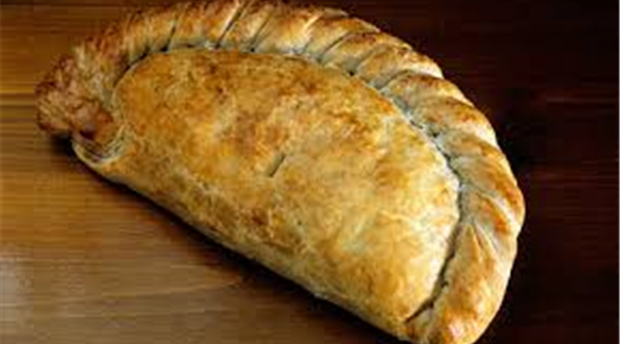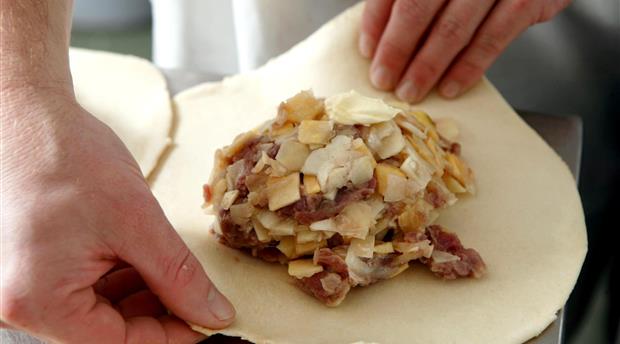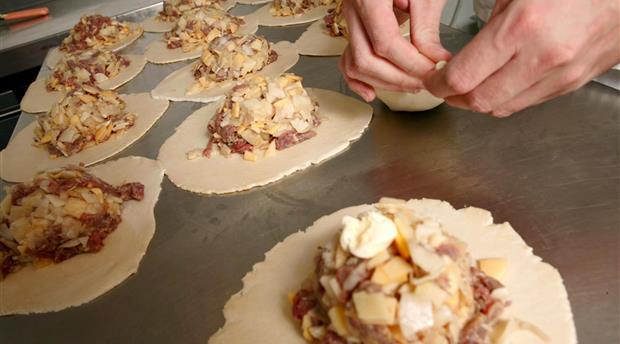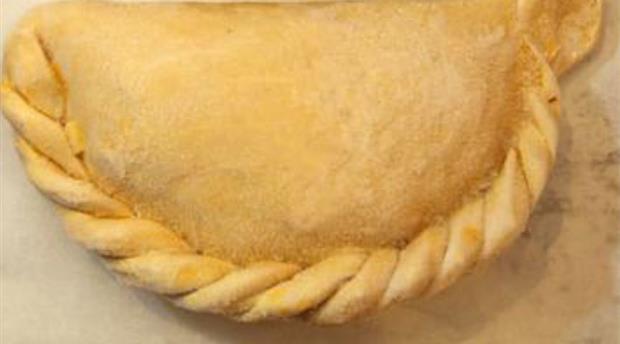This site uses cookies. By continuing to browse the site you are agreeing to our use of cookies. Read our privacy policy.
Cornish Pasty




(Swipe the logo for pictorial)
This recipe is for 4 good sized Cornish Pasties
METHOD
1. Pastry
- 500 gms strong bread flour (It is important to use a stronger flour than normal as you need the extra strength in the gluten to produce strong pliable pastry.
- 120 gms white shortening
- 25 gms cake margarine
- 5 gms salt
- 175 gms cold water
Mix fat lightly into flour until it resembles breadcrumbs.
Add water and beat in a food mixer until pastry clears and becomes elastic. This will take longer than normal pastry but it gives the pastry the strength that is needed to hold the filling and retain a good shape.
Leave to rest for 3 hours in a refrigerator, this is a very important stage as it is almost impossible to roll and shape the pastry when fresh
2. Filling
- 450 gms good quality beef eg. skirt
- 450 gms potato
- 250 gms Swede
- 200 gms onion
Salt & pepper to taste( 2/1 ratio)
Clotted cream or butter (optional)
Chop the above finely then add to the rolled out circles of pastry raw. Layer the vegetables and meat adding plenty o f seasoning. Put your dollop of cream or a knob of butter on top. Then bring the pastry around and crimp together. Try practicing on a potato first or just flatten like a turnover and mark with a fork. Crimping is the secret to a true Cornish pasty but it really has to be taught it is almost impossible to describe.
HANDY HINTS
- Always use a firm waxy potato such as Maris pier or Wilja.
- Put in plenty of seasoning.
- Ensure that all your veg is freshly prepared
- Never attempt to add carrot, this is sacrilege!!
Use a good cut of BEEF eg. skirt. This is the underside of the belly of the animal. Its juice produces wonderful gravy, has no fat or gristle and cooks in the same amount of time as the raw vegetables.
Butter or cream gives the pasty that extra richness.
- Cooking time and temperature
- Gas No6 approx 50 min-1 hour
- Electric 210 approx 50min-1 hour
- Fan assisted 165 approx 40 mins
This recipe shows how you can have a go at making a pasty yourself at home. Cornish pasties were awarded the Protected Geographical Indication (PGI) in 2011 and need to be made to the following specifications.
A genuine Cornish pasty has a distinctive ‘D’ shape and is crimped on one side, never on top. The texture of the filling is chunky, made up of uncooked minced or roughly cut chunks of beef (not less than 12.5%), swede, potato, onion with a light seasoning. The pastry casing is golden in colour, savoury, glazed with milk or egg and robust enough to retain its shape throughout the cooking and cooling process without splitting or cracking. The pasty is slow-baked and no artificial flavourings or additives must be used. And, perhaps most importantly, it must also be made in Cornwall.
The Cornish Pasty Association. Visit website for more details.

